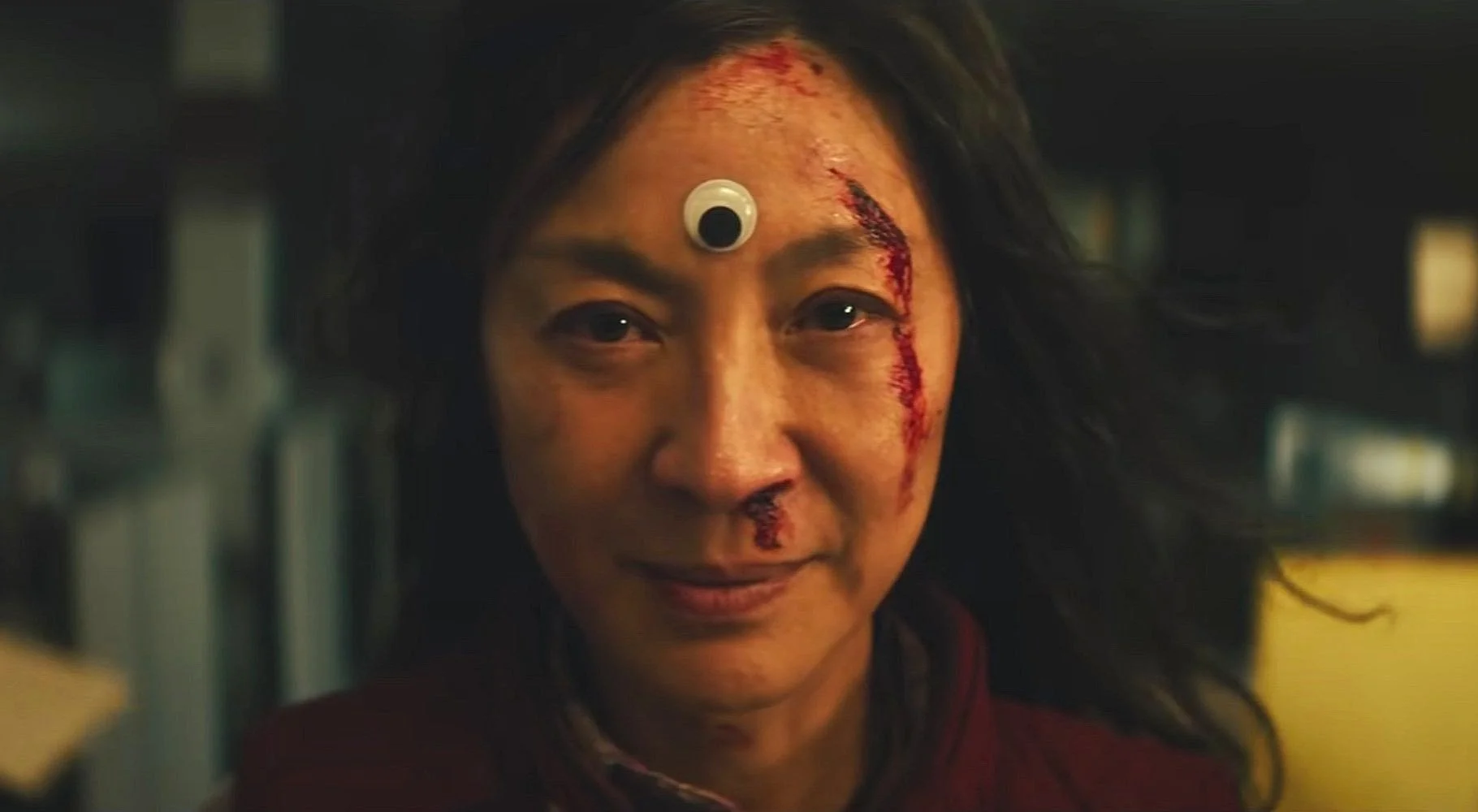Review: trying to have Everything Everywhere All At Once
It all begins as a regular day in the known universe. Evelyn Wang (Michelle Yeoh), owner of a modest laundromat, is preparing a year’s worth of receipts as part of an audit by the IRS. She bustles through her day, juggling a kowtowing yet discontented husband, Waymond (Ke Huy Quan), a demanding father (James Hong), and a frustrated, alienated daughter, Joy (Stephanie Hsu), as well as plans for a Chinese New Year party. She is overwhelmed; it’s like her head is about to split.
And sure enough, it does. While the family receives their audit from a dreary, condescending IRS inspector, Deirdre (Jamie Lee Curtis), the body of Waymond is taken over by an alternate version of Waymond — a man from another universe, who explains to Evelyn that there are as many universes as there have been choices made in a given person’s life. For each of Evelyn’s personal decisions, another alternate reality has been created in which she went with the other option.
Regretably, there is a form of technology in one of these universes that allows folks to hop between realities, or “verse-jump.” This different Waymond has appeared to warn Evelyn of an evil force that is seeking to destroy the metaverse, i.e. every reality. Somehow, it is now all up to her to access skills from a metaverse of selves — including one reality where she is a master of kung fu — to stop this evil.
That’s a lot of setup. Granted, it’s par for the course in sci-fi and superhero movies — and Everything Everywhere All at Once, the latest mind-bending fantasia from writer-director team Daniel Kwan and Daniel Scheinert, is a superhero movie if there ever was one. In Evelyn Wang, the Daniels have crafted the most unexpected, most glory-less hero to step in and restore order to our world (and as portrayed by Yeoh, she emerges as a commanding presence), but as I sat in the dark, watching it all unfold — universe after universe — I found myself recalling Peggy Lee’s disaffected refrain: “Is that all there is?”
One has to admire the Daniels for their audacity; their previous film, Swiss Army Man (2016), was a similarly whimsical, contrived foray into a protagonist’s splintered psyche — one that employed everything from farting corpses to erections which function as compass needles to illustrate how one man (Paul Dano) might project his unresolved personal issues onto a world of seemingly unrelated and inanimate objects (e.g., Daniel Radcliffe). The same is true of Everything Everywhere, which, in its cracking open of Evelyn’s mind, upends all “rules” of correlation or utility in her surrounding environment. She’s now able to do seemingly anything — not just kung fu, but play the piano, cook hibachi, and conduct a BDSM session. In other words, whatever tickles the Daniels’ momentary fancy.
I’m pretty sure that I will always find the logic of parallel universe stories to be unimpressive. In the case of Everything Everywhere, it struck me as laughable that universes should split on the basis of individual people’s “big” life decisions; why does the metaverse sit up and take notice when I move away from my hometown, yet doesn’t bat an eye when I forget to take out the trash? And we never see an alternate universe where Evelyn’s reality is effected by a decision made by another person in her life.
Of course, it’s all intended as a metaphor, and where the Daniels thrive is in their revelation that the arbitrary distinctions between “this” and “that” which govern our lives are as subject to disruption and inversion as the equally tenuous patterns of our minds. Their blurring of the lines between personal and collective consciousness is an inspired commentary not only on the relationship between person and place, but spectator and spectacle.
Yet what do their movies have to offer beyond concept? Certainly, Everything Everywhere is jam-packed with eye-catching quirks and quasars: the flash of a red carpet premiere gives way to a kung fu action sequence… a duel with dildos segues into throwing hands made out of hot dog fingers. One gets the impression of swimming through a kind of alphabet soup, having to parse through bric-a-brac to locate characters and clarify motivations across just one of the many universes at play.
To their credit, the Daniels do seem to maintain a firm command of all their creation’s unwieldy parts — yet for all its pointed parallels, their teeming map of delineations ultimately comes across as too tidy by half. The film is too calibrated, too decked out with baubles and bangles to arrive at any overwhelming sense of poignancy, as if the Daniels’ effort to keep track forces their proceedings to remain restrictively on track.
The fundamental relationship between Evelyn and Joy, which occupies the heart of this movie, is profoundly touching… to consider. I ask, why must we rely on a nearly two-and-a-half-hour metaphor to convey the complexity of their bond when I already saw everything I needed to understand it on Stephanie Hsu’s and Michelle Yeoh’s faces in the film’s first five minutes?
Everything Everywhere All At Once is as effective an evocation of what it feels like to watch a movie as anything I’ve ever seen. It is a novel attempt, a commendable curiosity that is right for existing, even if all it has to do from now on is occupy a place on the shelf of history.
